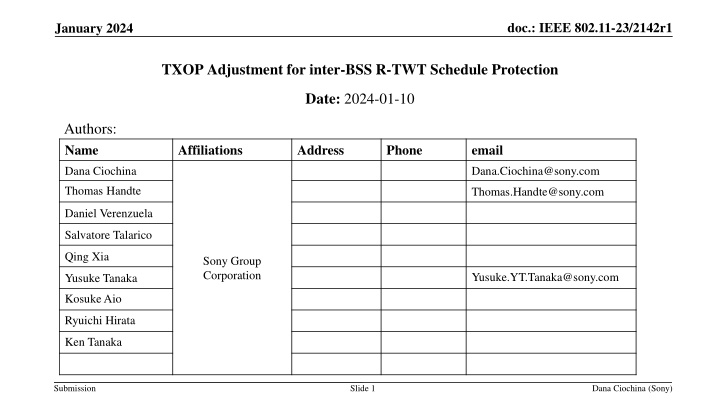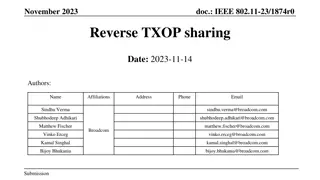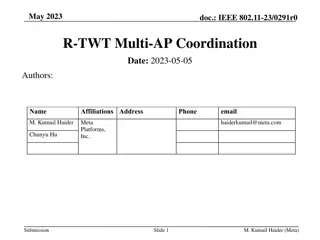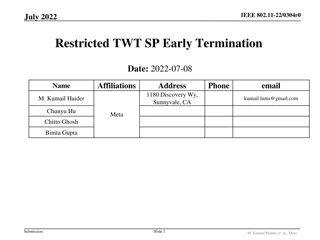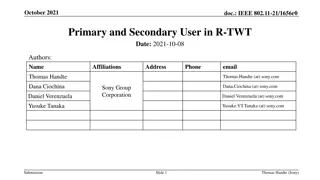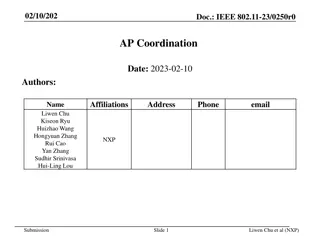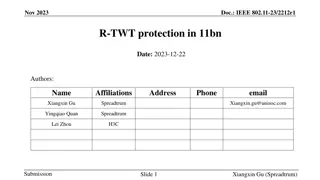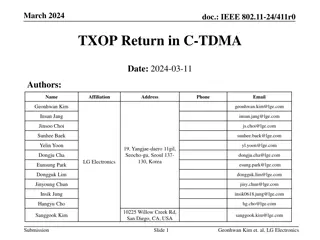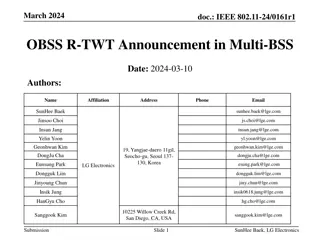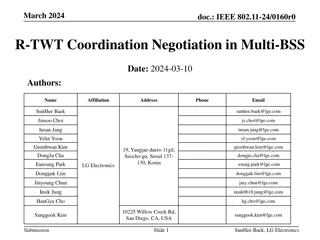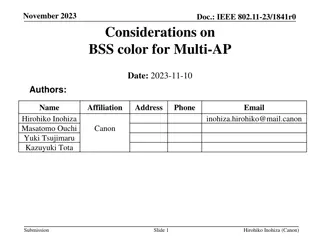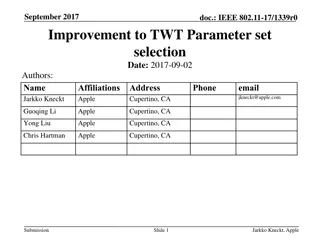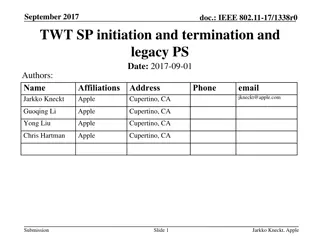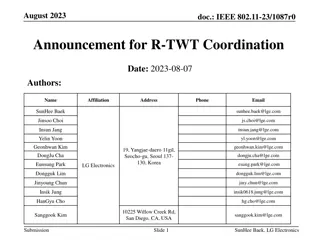IEEE 802.11-23/2142r1 TXOP Adjustment for Inter-BSS R-TWT Schedule Protection
This document explores challenges and proposed approaches for protecting R-TWT schedules in inter-BSS scenarios within the IEEE 802.11-23/2142r1 standard. The authors from Sony Group Corporation address the complexities of coordinating R-TWT schedules among multiple BSSs, considering factors like schedule propagation, quiet element protection, and STA requirements. The proposed approach involves individual handling by APs based on scheduling information and STA requests.
Download Presentation

Please find below an Image/Link to download the presentation.
The content on the website is provided AS IS for your information and personal use only. It may not be sold, licensed, or shared on other websites without obtaining consent from the author.If you encounter any issues during the download, it is possible that the publisher has removed the file from their server.
You are allowed to download the files provided on this website for personal or commercial use, subject to the condition that they are used lawfully. All files are the property of their respective owners.
The content on the website is provided AS IS for your information and personal use only. It may not be sold, licensed, or shared on other websites without obtaining consent from the author.
E N D
Presentation Transcript
doc.: IEEE 802.11-23/2142r1 January 2024 TXOP Adjustment for inter-BSS R-TWT Schedule Protection Date: 2024-01-10 Authors: Name Affiliations Address Phone email Dana Ciochina Dana.Ciochina@sony.com Thomas Handte Thomas.Handte@sony.com Daniel Verenzuela Salvatore Talarico Qing Xia Sony Group Corporation Yusuke.YT.Tanaka@sony.com Yusuke Tanaka Kosuke Aio Ryuichi Hirata Ken Tanaka Submission Slide 1 Dana Ciochina (Sony)
doc.: IEEE 802.11-23/2142r1 January 2024 Introduction R-TWT has been proposed as mechanism to prioritize low latency traffic [1] and is envisioned to assist in multi-AP coordination [2], [3] Current protection mechanisms are only applicable to intra-BSS scenarios Extensions for inter-BSS scenarios need to be defined Initial solutions to protect R-TWT schedules from oBSS STAs have been discussed in [4]-[7] Schedule coordination [4] Selective consideration of oBSS schedules [5]- [7] STAs reporting neighboring AP s R-TWT [5] Submission Slide 2 Dana Ciochina (Sony)
doc.: IEEE 802.11-23/2142r1 January 2024 Challenges regarding inter-BSS Protection Defining the right action to be taken based on scheduling information from multiple BSSs may depend on many factors Some STAs within a BSS may impact or be impacted by transmissions from a neighboring BSS, whereas others may not How much schedule information should be propagated How much should the quiet element protection be extended? Some schedules may be full or have critical start time requirements whereas others may be more flexible regarding the start time Various levels of coordination between the APs may be possible An EHT or UHR STA may have urgent low latency traffic to transmit even though it is not a member of the upcoming R-TWT Requiring non-AP STAs to respect quiet elements or large amount of schedule information from neighboring BSSs can be complex and inefficient Submission Slide 3 Dana Ciochina (Sony)
doc.: IEEE 802.11-23/2142r1 January 2024 Proposed Approach Idea Consider the original problem a STA from one BSS requests a TXOP overlapping with the R-TWT set up by an AP in another BSS ???? ???? - time interval from the end of the RTS until the start of the R-TWT ????? TXOP duration indicated in the RTS field Prerequisite the APs know the schedule information of neighboring APs Proposed approach allow an AP to handle such cases individually, depending on available scheduling information and requests from neighboring APs, as well as traffic requirements of the requesting STA Submission Slide 4 Dana Ciochina (Sony)
doc.: IEEE 802.11-23/2142r1 January 2024 Initial Solution for inter-BSS Protection Assumptions: no information available at AP2 regarding potential urgent traffic at STA2 (e.g., based on an SCS stream) not possible to accommodate STA2 traffic after the R-TWT boundary (due to e.g., interference levels, full schedule, or no multi-AP coordination scheme active) Solution: AP2 adjusts the parameters of an overlapping requested TXOP to indicate to stop the TXOP at the boundary of the incoming R-TWT or defer transmission, if the remaining time until the start of the R-TWT is too short ???? effective time that can be used by STA2 ?? optional time duration which may be defined to allow some protection to the start of the R-TWT set up by AP1 from STAs in BSS2 Adjusts the effective duration the TXOP can be used for, via ??, and ????parameters Submission Slide 5 Dana Ciochina (Sony)
doc.: IEEE 802.11-23/2142r1 January 2024 Initial Solution for inter-BSS Protection Implementation of the control frame Option 1: as a modified CTS The Duration of field of the CTS field should be modified to indicate as ???? the remaining time until the start of the R-TWT. Only one duration information can be set in this case (?? = ????) Option 2: as a modified DTS frame DTS frames were defined for DMG to indicate denial to send due to a set NAV, as well as the SA and DA of the NAV Setting STA. For the current proposal a DTS frame could be introduced for non-DMG modes, to indicate denial to use a part of the requested TXOP and potentially basic R-TWT information Option 3: as an MU-RTS TXS Trigger Frame In this case, the parameters would be set as: Duration field: ?? Allocation Duration: ???? Implies starting a new TXOP with the adjusted parameters Submission Slide 6 Dana Ciochina (Sony)
doc.: IEEE 802.11-23/2142r1 January 2024 Extended Solution - Protection with Fairness Constraints (1/3) Goal: balance both traffic requirements of STA2 and the schedule information Solution: AP2 adjusts the TXOP or initiates a new TXOP such that: a first part of the TXOP until the schedule could be used by STA2 the continuation is decided at R-TWT border depending on the traffic type, schedule parameters, coordination information and prior negotiation between the two APs Figure: Example with one type of continuation Submission Slide 7 Dana Ciochina (Sony)
doc.: IEEE 802.11-23/2142r1 January 2024 Extended Solution - Protection with Fairness Constraints (2/3) A continuation can be: allowed if STA2 traffic has similar TID as the one in the R-TWT or urgent transmission requirement allowed in C-TDMA fashion, if previously negotiated between APs e.g., hand over remaining TXOP to AP1 allowed with adjusted transmit power, if CSR is possible e.g., overlap UL transmissions with adjusted power not allowed if none of the conditions above satisfied E.g., continuation is a CF-End with the PPDU ending at the border of the R-TWT start Submission Slide 8 Dana Ciochina (Sony)
doc.: IEEE 802.11-23/2142r1 January 2024 Extended Solution - Protection with Fairness Constraints (3/3) Implementation The control frame can be implemented as an MU-RTS TXS with ??the allowed duration of the TXOP and ???? the initial allocation duration of STA2 traffic Continuation frame can be implemented as MU-RTS TXS with ????as further allocation duration in case of a continuation of STA2 traffic MU-RTS TXS with ????as remaining allocation duration to be used by AP1 and member STAs CF-End in case of termination The transmission start of the PPDU carrying the indication of the continuation type can be chosen according to negotiated coordination schemes (e.g., CTDMA, CSR..): if no coordination, before the R-TWT if coordination, at the start of the R-TWT interval Submission Slide 9 Dana Ciochina (Sony)
doc.: IEEE 802.11-23/2142r1 January 2024 Pros and Cons Advantages of the proposed solutions: Low implementation complexity at non-AP STA The proposed solutions can improve the protection mechanisms from oBSS STAs, without requiring the oBSS STAs to determine, save or respect a large amount of schedule information Existing frameworks can be adapted to implement the proposed methods The proposed techniques can be further enhanced to consider different coordination techniques Disadvantages Allowing an AP to change the TXOP parameters that a STA requested should be done with care to avoid overuse and to guarantee fairness A STA may need to reparse the packets to fit the adjusted TXOP duration Submission Slide 10 Dana Ciochina (Sony)
doc.: IEEE 802.11-23/2142r1 January 2024 Summary Protection mechanisms for scheduling intervals from oBSS STAs still need to be defined Schedule information exchange and negotiation may be heavy on the non-AP STAs We have introduced a mechanism to increase the protection of an R-TWT from oBSS STAs with two flavors Both aim at limiting the amount of schedule information and rules that a non-AP STA needs to follow The initial solution assumes an AP adjusting a requested TXOP based on R-TWT information An enhanced solution assumes an AP adjusting a requested TXOP based on, in addition to the R-TWT information, the traffic requirements of the oBSS STA Submission Slide 11 Dana Ciochina (Sony)
doc.: IEEE 802.11-23/2142r1 January 2024 References [1] 11-20/1046r12 Protected TWT Enhancement for Latency Sensitive Traffic [2] 11-23/226r2 Considerations for AP coordination in UHR: Coordinated Medium Access [3] 11-23/rTWT for Multi-AP [4] 11-23/291 R-TWT Multi-AP Coordination [5] 11-23/250r0 AP Coordination [6] 11-23/0771r0 Coordinated R-TWT Protection in Multi-BSS [7] 11-23/1087r0 Announcement for R-TWT Coordination Submission Slide 12 Dana Ciochina (Sony)
